|
Edited
by Frank R. Shaw, FSA Scot, Dawsonville, GA, USA
Email:
jurascot@earthlink.net
While this site was started over a decade ago as
book review space for Scottish books, I must confess “the times, they are a
changin” and I find myself working with a blog by good Burnsian friend
Stephen Hammock. This web site has evolved from book reviews into “Chats
with Authors”, a couple of Scottish prayers, tributes to old friends, and
trips to Scotland and Paris and, sadly, an obituary or two among the
articles. But this is my first attempt in dealing with a blog. I was so
impressed by Stephen’s work that I post here it in the hope that some of you
will be inclined to sign up and view the paths he will be following in the
years ahead in the States and in the United Kingdom.
Stephen Hammock is studying at Oxford University
for a doctorate and has now completed his first year. He spent the summer
months back in Georgia and recently returned to Oxford for the next step in
search of his degree. He is a bright young man and we came to know each
other when he joined the Burns Club of Atlanta. In our last email exchange
he said, “I need to add an article on Burns sometime!” That is something all
of us would like to read, Stephen, so I will hold you to it! Best wishes for
a great year at Oxford and thanks for sharing ramblingmuser with our
readers.
(FRS: 9.26.13)
ramblingmuser
literature,
archaeology, philosophy, exploration

←
Older posts
Posted on
September 9, 2013
by
shammock2012
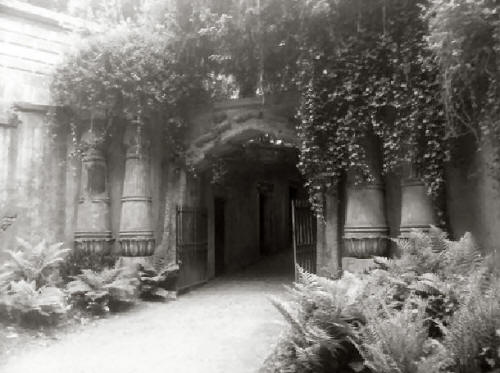
Highgate Cemetery in London, England is a PHANTASTIC treasure
of Victorian sculptural sepulchres. A recent visit confirmed my hopes and
expectations, although I must say that the overly engineered tour was a bit
heavy-handed and I wish it had been possible to just wander around freely.
Since black and white photos of Highgate seem to do it the most justice,
here is a visual tour of it as nineteenth century photographs might have
depicted it.
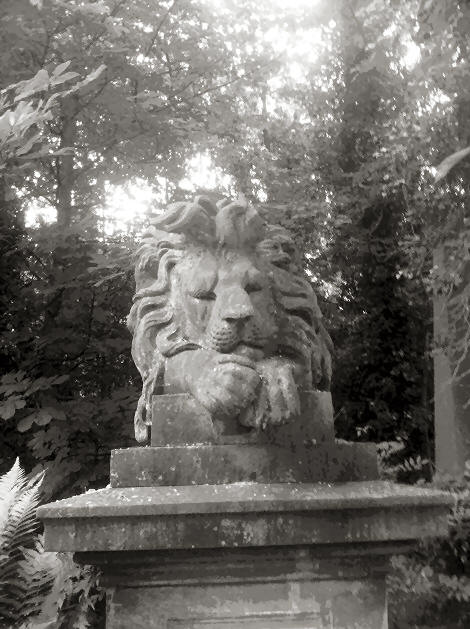
George Wombwell
Monument
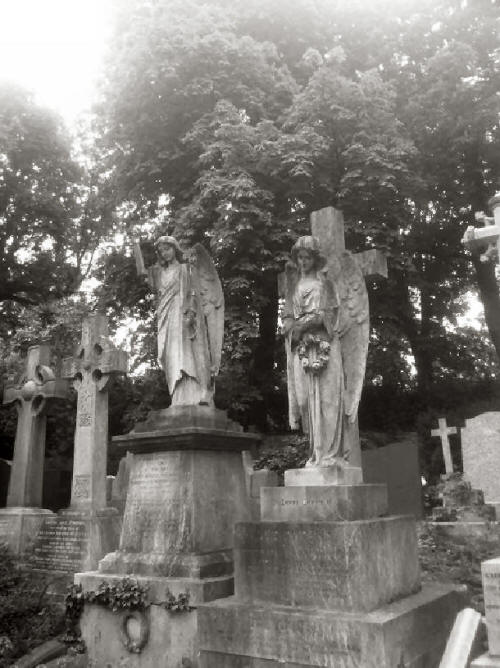
The Angels of Highgate
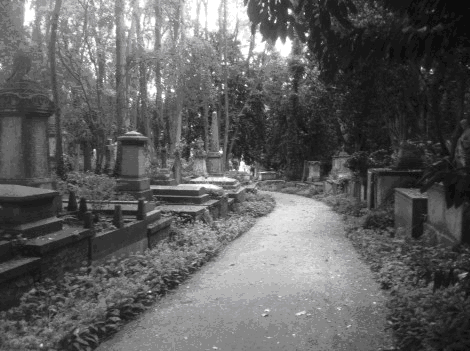
Highgate Cemetery
Path
The biggest regret was that the tour group was not taken to
see the grave of Elizabeth Siddal, the Pre-Raphaelite muse of Dante Gabriel
Rossetti, which we were looking forward to with excitement. Rossetti is
rumoured to have painted thousands of paintings of Siddal, whom he later
married, including the sensual Beata Beatrix, and his sister Christina once
described his obsession with this muse in verse. When she died in 1862,
Rossetti buried his sole surviving copies of his poems with her, an act
which he later regretted. Another regret that haunted him for the rest of
his life was the fact that he had her exhumed so he could reclaim the poetry
and publish it. It is said that her flowing red hair had somehow continued
to grow after her death, and that the coffin was overflowing with it….
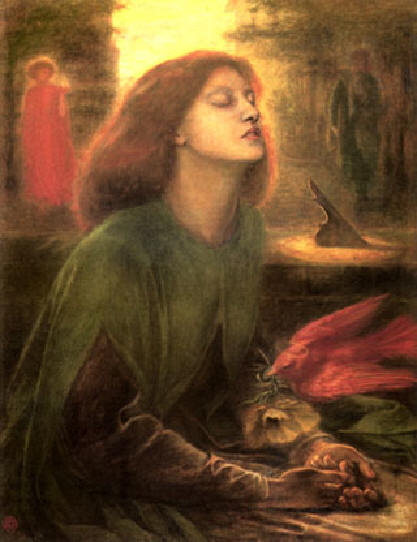
Beata Beatrix by
Dante Gabriel Rossetti
“One face looks
out from all his canvases,
One selfsame figure sits or walks or leans:
We found her hidden just behind those screens,
That mirror gave back all her loveliness.
A queen in opal or in ruby dress,
A nameless girl in freshest summer-greens,
A saint, an angel — every canvas means
The same one meaning, neither more nor less.
He feeds upon her face by day and night,
And she with true kind eyes looks back on him,
Fair as the moon and joyful as the light:
Not wan with waiting, not with sorrow dim;
Not as she is, but was when hope shone bright;
Not as she is, but as she fills his dream.”
Christina Rossetti,
In An Artist’s Studio, 1856
Categories:
Cemeteries,
Exploration,
Literature
|
Tags:
cemetery,
Highgate,
London,
Victorian |
Posted on
July 25, 2013
by
shammock2012
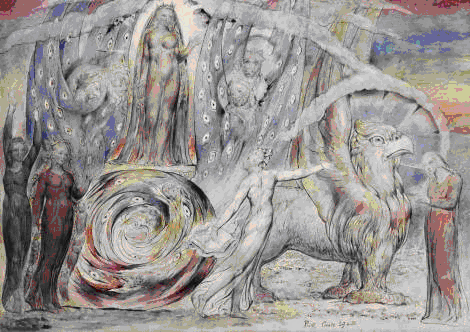
Beatrice Addressing Dante from the Car by William Blake
Thomas Carlyle wrote that the greatest poets are also
prophets, and experience life on quite another sphere than their fellow
mortals. Though others may forget the sacred mysteries of life and come to
believe in appearances alone, the true poet cannot forget them because he
lives in them and is completely honest and dedicated to their universal
power. Homer, Dante, and Shakespeare, surely our three greatest poets,
support this idea of the poet/prophet, or Vates, and if we would seek to
understand such genius, we would do well to contemplate this truth – that
they are attuned to a key that the masses of men cannot or will not hear. It
is this that makes them unique even among poets, who are all commonly
regarded as having more sensitive natures, and it is this that also makes
understanding them a greater challenge.
Of these three most universal of poets, Dante alone combines
spiritual depth with intellectual vigor and intense lyrical sweetness.
Although he began writing in the Courtly Love tradition that swept across
Europe in the Middle Ages – a tradition invented by the troubadours of
southern France – Dante transformed this tradition when he wedded to it the
dolce stil nuovo (sweet new style), a literary movement popular among
Italian poets of his time. The primary characteristics of this style of
poetry were not only introspection, puns, and philosophical themes, but also
an insistence that the beautiful women about whom these poets wrote were
actually angelic beings. Dante took this last theme a step farther than any
of his contemporaries by insisting that one angelic lady in particular was
literally sent to Earth to show him the way to Heaven. He describes her and
his love for her in his poetry manual La Vita Nuova (The New Life) and in
his great epic The Commedia (The Comedy). The rest of this essay will
explore the life and ideas of this Mediaeval Italian Vates.
Dante was born in Florence in AD 1265 into a noble but
impoverished family. His father made a decent living by leasing out family
farmlands just north of the city. Although Dante had the advantages of an
urban education and manners, and was fiercely devoted to his hometown,
descriptions of country life also fill his poetry and show how deeply Nature
touched his great spirit. However, the central event in his life occurred on
May 1, 1274, when he was about nine. This is when he met eight year old
Beatrice Portinari at a party given by her father, and from that day forward
love fired his young heart. Soon he began to seek her out in the markets,
churches, and streets of the neighborhood where they lived, and although he
probably never knew her well, Dante came to see in Beatrice his ideal lady
of beauty, grace, and piety, and wrote a number of sonnets and poems in her
honor. In fact, her very name comes from the Latin Beatrix, and literally
means “one who makes happy.” Tragically, Beatrice died in 1290 at the age of
24.
Dante wrote a few more poems for her, combined them with
prose explanations of how he came to write them, and set them forth around
1295 under the title La Vita Nuova. Though he appears to have tried for a
while to forget her, her image was so emblazoned on his mind that he ended
up making her the central figure of his poetry and of his life. Over time
she has become the most memorable literary character in world history. For
it is certain that the immortal figure we meet in his writings is an
idealized version of the real girl he loved, and who married someone else
and died young. Dante also married, but, as was customary in Mediaeval
Europe, his was arranged by his family when he was about eleven. The
contract was fulfilled in late 1287, and four children resulted from this
union.
Dante studied philosophy and theology deeply in the years
after Beatrice’s death, and immersed himself in the Republic of Florence’s
politics from 1295-1301. Perhaps he became too involved in the factional
struggles that continually rocked his native city throughout the 13th and
14th centuries, but things came to a head when he became outspoken against
the secular politics of Pope Boniface VIII. Boniface was attempting to
increase the power of the papacy, and sought to undermine any Italian
city-states that were independent of his authority. His stratagems were but
one episode in the Middle Age struggle between the popes and the Holy Roman
Emperors, who argued that popes had power only over religious matters, while
the emperors controlled all secular matters. All Florentines nominally
supported the church in its endeavors and wars against the empire, but some,
like Dante, thought that Florence’s independence was more important than
serving either master too well. In this regard, Dante was sent as papal
ambassador to Rome in 1301 to argue for his city’s continued freedom. Though
the other Florentine ambassadors were soon allowed to leave, Boniface,
fearing Dante’s eloquence, purposefully delayed his return until the faction
supporting papal authority had time to violently wrest control of the city
from Dante’s party. Dante would never forgive Boniface for this, and would
later blacken the pope’s very name in a manner unique in the history of the
papacy. Dante was ultimately exiled from Florence and condemned to death by
his political enemies. However, the fame of his poetry and other writings
had made him a celebrity, and after a few years if intense poverty, he lived
comfortably for the rest of his life, though he wandered from city to city
and host to host, and became the ultimate example of the exiled
intellectual.
Dantean scholars have emphasized particular aspects of his
work and influence that make him one of the two or three greatest poets of
all time. C. S. Lewis wrote of Dante’s love poetry being a union of divine
and sensual love, John Freccero offered that Beatrice reconciles human love
with the Divine plan, and Harold Bloom said she is “the allegory of the
fusion of sacred and secular, the union of prophecy and poem.” T. S. Elliott
wrote that Dante’s poetry has “the quality of surprise” that E. A. Poe said
was “essential to poetry,” while Bloom proffered that Dante’s works have “a
strangeness” that we can never completely internalize, and that it is this
that gives his poetry its startling originality. Carlyle simple wrote that
intensity is “the prevailing character of Dante’s genius.” Northrop Frye
suggested that Dante’s Commedia is the supreme example in literature of the
“marvelous journey,” while Erich Auerbach said that Dante’s poetry is
spell-binding, and that readers are charmed into entering a magical world.
Dante’s influence has been immeasurable, largely through the
impact he had on Petrarch, whose sonnets and poems in turn created romantic
poetry as we understand it today. Dante’s philosophy and theology have cast
a giant shadow upon subsequent thinkers, visionaries, churchmen, and
authors. His use of the vernacular Italian, as opposed to the more
acceptable Latin, linguistically changed just about everything. But more
than anything else, it is Dante’s great lyrical power as a poet that gives
him his charm, his darkness, his hope, and his radiance. All of the writers
quoted above touch upon some of the aspects that place Dante’s poetry in a
class by itself. But perhaps Bloom, the most eloquent of Dante’s admirers
after Carlyle and Elliott, summed it up best when he wrote that Beatrice was
“a Christian muse” and that for Dante, “love begins and ends” with her.
For Dante’s greatest works,
The Commedia and
La Vita Nuova, are first and
foremost poems about love, and Dante is primarily a poet/prophet of love,
whether earthly or spiritual, whether of the flesh or of the soul. No one
wrote anything like he did before he lived, and no one has come close to his
daring or his depth since he died. When one considers that the girl Dante
loved only uttered a handful of words to him during their lives, it is
almost impossible for us to comprehend that with words alone, he created a
poetic vision so unique and so influential that it is best summed up with
the one word he made synonymous not only with himself, but with Love itself.
That word is simply the name of the Muse who made him happy and who led him
beyond himself even after her death and his exile from Florence: Beatrice.
Without Dante’s vision of Beatrice, Love as we understand it today – if we
can be said to understand it at all – would be but a shadow of itself, and
we would be immeasurably poorer both philosophically and poetically for this
loss. Bless Beatrice! Bless Dante! And bless all those who risk their hearts
in the great adventure known as Love.
Her color is
the pallor of the pearl,
A paleness perfect for a gracious lady;
She is the best that Nature can achieve
And by her mold all beauty tests itself;
Her eyes, wherever she may choose to look,
Send forth their spirits radiant with love
To strike the eyes of anyone they meet,
And penetrate until they find the heart.
You will see Love depicted on her face,
There where no one dares hold his gaze for long.
Dante,
an excerpt from the poem “Ladies who have intelligence of love” in
La Vita Nuova (The
New Life), circa A.D. 1295, translated by Mark Musa, 1973
Categories:
Literature
|
Tags:
Beatrice,
Commedia,
Dante,
dolce stil nuovo,
La Vita Nuova,
William Blake |
Posted on
July 7, 2013
by
shammock2012
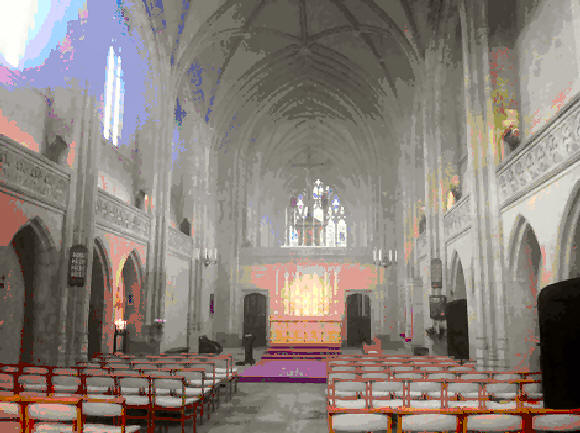
Pusey House is a very special chapel that shares facilities
with St. Cross College at the University of Oxford. Established in 1884 in
honor of one of the founders of the Oxford Movement, which sought to return
the Anglican Church to the more formal service of the early days of the
English Reformation – before the rise of the Puritans – it was named for Dr.
Edward B. Pusey (1800-1882), who took up the mantle of leadership of the
Anglo-Catholic tradition within the Church of England after John Henry
Newman converted to Catholicism. Pusey House Library comprises Pusey’s own
vast library and many other books acquired or donated since Pusey’s death.
The service is beautiful and traditional, with Solemn High
Mass on Sunday mornings that some would say is more Catholic than Catholic,
something which has surprised even those familiar with the modern Anglican
church, including a friend with whom I attended. The sermons/homilies are
engaging and quite often penetratingly witty and apropos, as befits the
grandeur of this old university city. But I must say that the music is the
part that is truly ethereal and hauntingly beautiful, and the small ensemble
making up Pusey House Choir fill the chapel with the sounds of Byrd, Tallis,
Mozart, Vaughn Williams and others every week during term time. Even those
familiar with the masses of these composers receive a chill upon hearing
such sounds during the solemnity of a High Mass, in the midst of the “smells
and bells” of the Anglo-Catholic rite. Simply put – I have never heard such
singing and pipe organ playing in a church of this size, and only very
rarely in the greatest cathedrals. Ironically, perhaps only the word “magic”
can possibly describe the hard work and pain-staking practice that
inevitably results in such spine-tingling sacred song.
After each Sunday morning mass a reception is held where
juice, wine, and sometimes champagne are served and where visitors and
members can meet the priests, sacristan, and the Friends of Pusey House.
There are also periodic suppers and dinners within the House and the
priests, who are fellows of St. Cross College, can often be seen and met
whilst entertaining their guests at various St. Cross dinners.
As the sacristan’s emails say to the elect, as those simply
on the email list may be called, it truly is beautiful and intelligent
religion!
“I was glad when they said unto me, let us go into the house
of the Lord….”
King David of Israel,
Psalm 122, ca. 1000 B.C.
(King James Version, A.D. 1611) (This psalm has been set to music several
times and is traditionally sung during the coronation of British monarchs)
Categories:
Churches
|
Tags:
Choir of Pusey House,
Dr. Edward B. Pusey,
Oxford Movement,
Pusey House Chapel,
Solemn High Mass,
St. Cross College,
University of Oxford |
Posted on
June 10, 2013
by
shammock2012

Last summer I took a trip to visit a friend on one of
Georgia’s Golden Isles to record archaeological sites. Little Cumberland
Island (LCI) is a private island owned by an association of homeowners, so
it was a wonderful privilege to be invited there at all! The purpose was to
record the coordinates of a few surface scatters of artifacts that had
become exposed by waves and wind on the beach and in the sand dunes.
After crossing over from Jekyll Island by boat and a lovely
evening with my hosts, we started bright and early on our peregrinations, as
we knew the day would be hot. There was still no way to imagine just how
hot! It felt like 100 degrees Fahrenheit in the shade, with 100% humidity,
by eleven o’clock in the morning! But we pushed on through, and visited
several sites including a couple Archaic period shell middens, a prehistoric
ceramic-making site, a Union sailor’s relocated grave, and the lovely tabby
lighthouse.
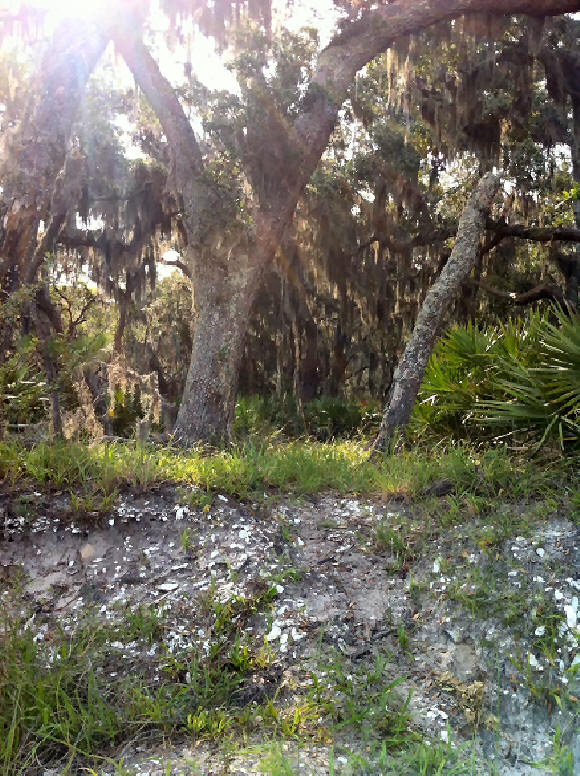
An Archaic Shell-Midden
on LCI
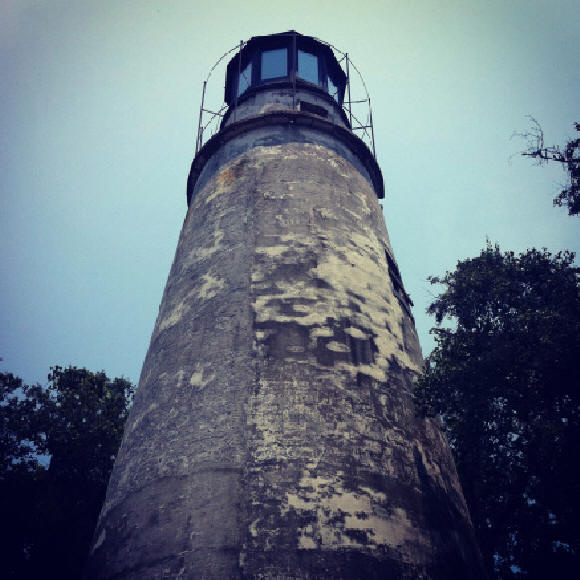
LCI Lighthouse
It was a unique experience that I hope to repeat some day,
and I am indebted to my hosts for their hospitality and the opportunity to
visit a special place that even most Georgians never see. And we even got to
see the wild horses on the beach!
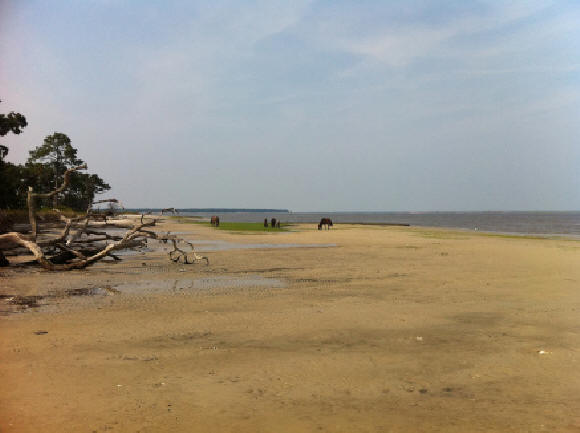
LCI’s Wild Horses
“The sun was
shining on the sea,
Shining with all his might:
He did his very best to make
The billows smooth and bright….”
Lewis
Carroll,
The Walrus and the Carpenter,
1872
Categories:
Archaeology,
Exploration
|
Tags:
archaeology,
Georgia,
Jekyll Island,
Little Cumberland Island |
Posted on
June 6, 2013
by
shammock2012
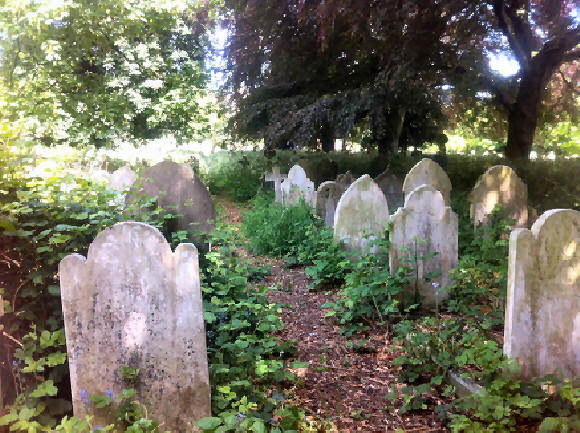
Two of us ramblers recently took a walk up Jericho way
looking for a hidden cemetery called St. Sepulchre’s, a Victorian graveyard
on the site of an old farm. Despite containing still more examples of
vandalism and neglect amongst Oxford cemeteries, as well as a great many
graves completely overgrown with grass and briers, it was a beautiful spring
day and we were able to take some charming photographs of the scene and
setting. Quite a few leading Oxonians, masters of colleges, and mayors are
interred at St. Sepulchre’s, the most famous probably being Benjamin Jowett,
Master of Balliol College and arguably the most famous translator of Plato’s
dialogues and other classical works into English.
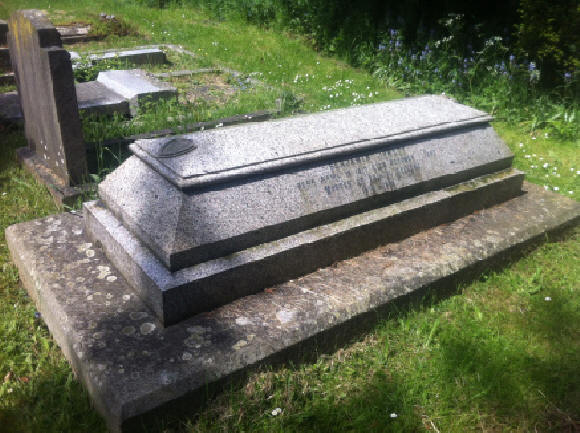
Grave of Benjamin
Jowett
Additionally, a highly interesting group of stones mark the
places where the Sisters of the Society of the Holy and Undivided Trinity
(commonly called Sisters of Mercy) were laid to rest. These Anglican nuns
had deep-rooted connections to the Reverend Dr. E. B. Pusey and the Oxford
Movement, and were led by Mother Superior Marian Rebecca Hughes – the first
woman to take vows as an Anglican nun since Henry VIII’s dissolution of the
monasteries during the English Reformation. Interestingly, Mother Marian was
also the sister of Thomas Hughes, the author of the classic Victorian school
boy novel Tom Brown’s School Days.
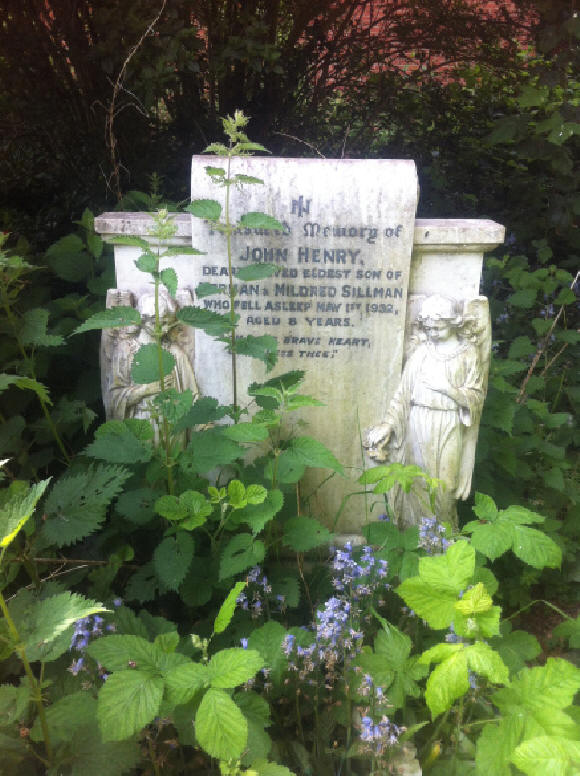
Grave of Eight Year Old John Henry Silliman
Ah – the gems
of largely forgotten places and memorials to our predecessors that exist in
“this blessed plot, this earth, this realm, this England!”
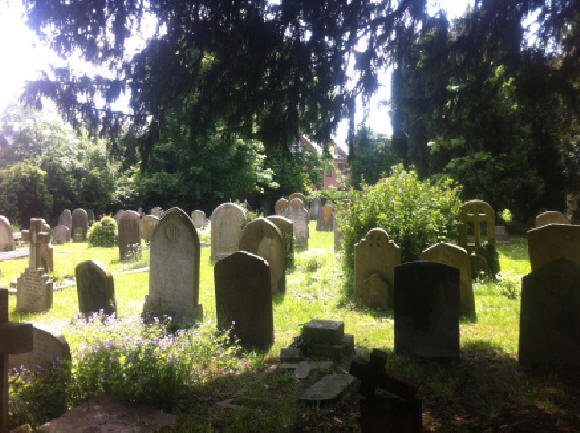
“…either death is a state of nothingness and utter
unconsciousness, or, as men say, there is a change and migration of the soul
from this world to another. Now if you suppose that there is no
consciousness, but a sleep like the sleep of him who is undisturbed even by
the sight of dreams, death will be an unspeakable gain….Now if death is like
this, I say that to die is gain; for eternity is then only a single night.
But if death is the journey to another place, and there, as men say, all the
dead are, what good, O my friends and judges, can be greater than this?…What
would not a man give if he might converse with Orpheus and Musaeus and
Hesiod and Homer? Nay, if this be true, let me die again and again.”
Plato,
Apology, Socrates’ Last
Words, ca. 399 B.C.
Translated by
Benjamin Jowett, 1871
Categories:
Cemeteries,
Exploration,
Literature
|
Tags:
cemetery,
Jowett,
Mother Marian,
Pusey,
St. Sepulchre's,
Thomas Hughes,
Tom Brown |
Posted on
May 30, 2013
by
shammock2012
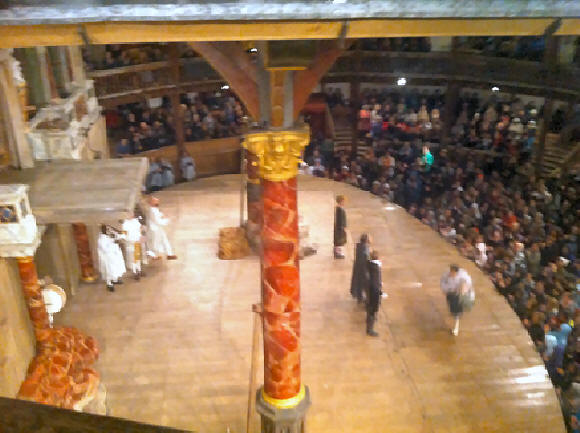
The reconstructed Globe Theatre is a magical place! Although
it does not sit on the exact location of the original, Elizabethan
construction techniques and architectural details were researched and
followed as closely as possible. Ironically, this new vessel for presenting
the plays of Shakespeare’s genius and those of his brilliant contemporaries
like Marlowe, Beaumont & Fletcher, Jonson, Middleton, Kyd, and the rest was
the vision of American actor Sam Wanamaker. Based on contemporary drawings
and descriptions of Elizabethan theatres like the Swan, and on modern
archaeological investigations of the Rose and original Globe, the new Globe,
which opened in 1997, is truly a beautiful work of architecture.
And to watch a Shakespearean play performed there, as I did
recently, is an enthralling and mystical experience. For despite the
Oxfordians and others who crop up like termites from time to time insisting
that Shakespeare did not write Shakespeare because he was not educated well
enough and came from the lower middle classes, it is abundantly clear to
anyone with less than half a brain that the glover’s son from smalltown
Stratford-upon-Avon, through the hard work of his hands and an explosion of
creativity in his mind, is indeed the playwright of
Hamlet,
Macbeth, and the rest.
The Tempest
was on the night a friend and I were in attendance at this new “wooden O”
after a wonderful day in London visiting various landmarks. It was
authentically enacted in Elizabethan garb, and performed so well that it
brought out ideas that had not occurred to me merely by reading this play of
magic and illusion numerous times. The actors were surely, to paraphrase
Shakespeare’s friend, rival, and inspiration Chrisopher Marlowe, “no spirits
but the true substantial bodies” of Prospero, Miranda, Ariel, Trinculo, and
the rest, until the spell was broken and the magic scene disappeared from
the stage forever – except perhaps in the minds of the playgoers!
“Our revels now
are ended. These our actors,
As I foretold you, were all spirits and
Are melted into air, into thin air:
And, like the baseless fabric of this vision,
The cloud-capp’d towers, the gorgeous palaces,
The solemn temples, the great globe itself,
Yea, all which it inherit, shall dissolve
And, like this insubstantial pageant faded,
Leave not a rack behind. We are such stuff
As dreams are made on, and our little life
Is rounded with a sleep.”
William
Shakespeare,
The Tempest, 1611
Categories:
Archaeology,
Literature,
Theatre
|
Tags:
Globe,
Marlowe,
Oxfordians,
Prospero,
Shakespeare,
The Tempest |
Posted on
March 30, 2013
by
shammock2012

This is an amazing new exhibit in England that I just
happened to walk by when I was at the Pitt Rivers recently. These shirts
date to around 1850, when they were given to British officials operating
near the U.S.-Canadian border (Montana/Alberta), and they eventually found
their way across the pond. The Blackfoot themselves seem to have had no
knowledge of them until a few years ago, when some dignitaries were invited
to inspect them and help contextualize them for the museum. It was
immediately apparent that these were sacred items that should be shown to
the Blackfoot people at large, so the five shirts (three of which are
currently on display in Oxford) were loaned out to local museums in the U.S.
and Canada so this could happen. The impact was tremendous, as Blackfoot
men, women, and children responded powerfully to these shirt their ancestors
had made by hand and generously given away. It was another outstanding
example of Native American heritage abroad that I have been overjoyed to run
across thousands of miles from home here in the UK!

Blackfoot Shirt
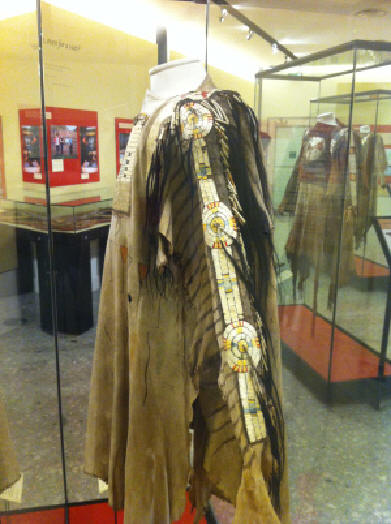
Side of Shirt
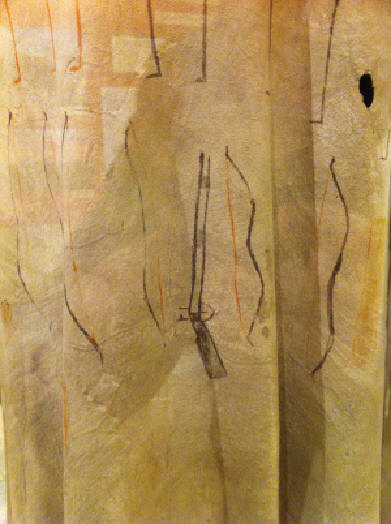
Shirt Detail
showing bows and musket

Painting Depicting
One Shirt
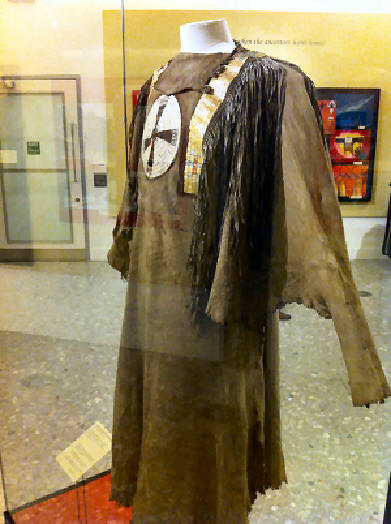
Blackfoot Shirt
“A little while
and I will be gone from among you, when I cannot tell. From nowhere we came,
into nowhere we go. What is life? It is the flash of a firefly in the night.
It is the breath of a buffalo in the wintertime. It is the little shadow
which runs across the grass and loses itself in the sunset.”
Chief
Crowfoot of the Blackfoot,
Deathbed Speech, 1890
Categories:
Archaeology,
Museums
|
Tags:
Blackfoot Indians,
Blackfoot Shirts,
Crowfoot,
Native American,
Pitt Rivers |
Posted on
March 26, 2013
by
shammock2012
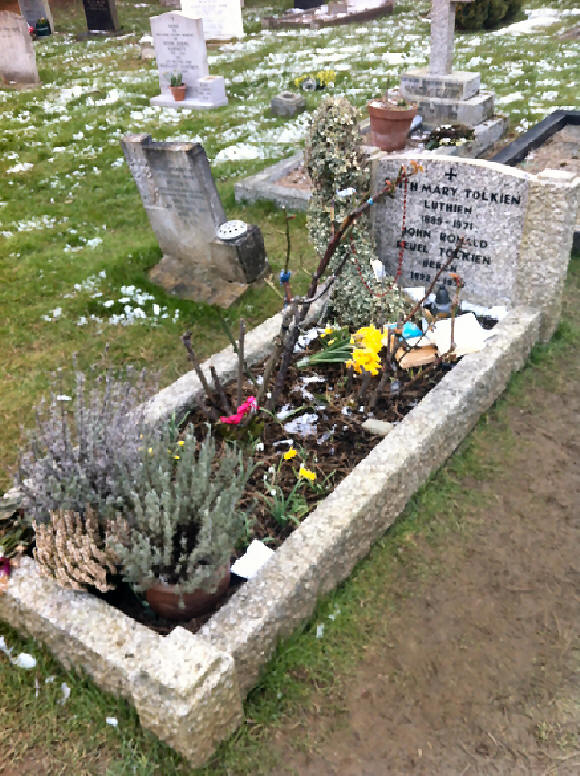
Exploring cemeteries has long been a favorite pasttime.
Recently I chose a blustery wintry day in early Spring to walk to Wolvercote
Cemetery, north of Oxford, to visit the grave of one of the greatest
imaginative storytellers of the 20th century – J. R. R. Tolkien. I savour
these moments so much, however, that I only went to his grave after
exploring the rest of the cemetery for over an hour, building up the
suspense! Seeing the graves of children along the way, decorated with their
toys and cards from their parents, is always so touching. I cannot fathom
the sadness those families must have felt and will always feel. Oxford
scholars, priests, rabbis, mothers, and fathers – all are represented at
Wolvercote. Even a minister from Kentucky with a Cherokee motto on his
tombstone! The grave of Tolkien and his wife was worth the wait –
especially because of the copies of his books and notes and tokens left by
his readers. Such an ordinary British grave in an ordinary British
cemetery. That speaks volumes.
Another thing has struck me about Oxford’s cemeteries, and it
is not at all positive. There are far too many vandalized graves here for
such an affluent community. Rose Hill Cemetery, just east of Oxford, is no
different. What possesses the living to destroy the houses of the dead? I
have long been a believer that the callousness of those who would destroy
graves for no reason is not far removed from the hatred and reckless
destruction that causes others to take the lives of of living human beings
for no reason.
“All we have to
decide is what to do with the time that is given us.”
“Not all those
who wander are lost.”
“It’s a dangerous business…going out your door….You step onto
the road, and if you don’t keep your feet, there’s no knowing where you
might be swept off to.”
J. R.
R. Tolkien,
The Fellowship of the Ring,
1954
Categories:
Cemeteries,
Exploration,
Literature
|
Tags:
Cemeteries,
graves,
Oxford,
Tolkien,
Wolvercote |
Posted on
March 24, 2013
by
shammock2012

Exploring the Ocmulgee, Oconee, and Flint Rivers of Middle
Georgia is not for the faint of heart, but for the adventurer! Whether by
kayak, canoe, or motor boat, by foot on trails or along densely wooded banks
where no path has been trodden, in the water with a mask and snorkel or
SCUBA gear, or in the sky by helicopter or plane, there are many ways of
looking for long lost traces of Native American dwellings, mounds, fishing
weirs, and towns, and for the forts of the soldiers and homes and ferries of
the early settlers who followed in their wake. The most important aspects
are obtaining the landowner’s permission and knowing someone on the ground
in any given locale. This person is the key to the success of any explorer,
and it is they who serve as escort and guide through the snares and tangles
not just of briars and brambles, but of local indifference or
misapprehension. When it becomes clear that knowledge and the subsequent
enrichment of the community are the ONLY goals, then most are interested in
helping sooner or later.
“If the doors of perception were cleansed every thing would
appear to man as it is, Infinite. For man has closed himself up, till he
sees all things thro’ narrow chinks of his cavern.”
William
Blake,
The Marriage of Heaven and Hell,
1790
Categories:
Archaeology,
Exploration,
Literature
|
Tags:
doors of perception,
Flint,
Kayak,
Ocmulgee,
Oconee,
River,
William Blake |
Posted on
March 20, 2013
by
shammock2012
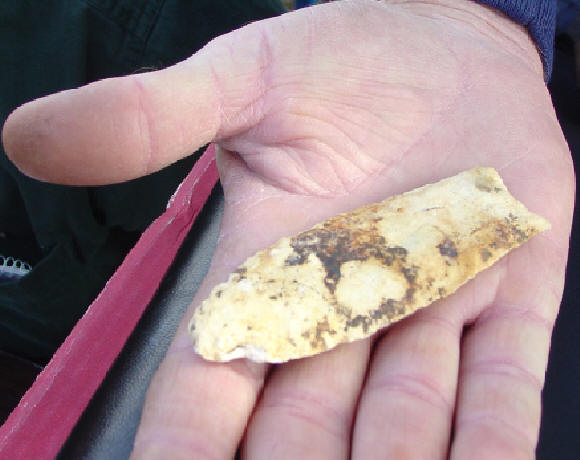
“There is scarcely a square rod of sand exposed, in this
neighborhood, but you may find on it the stone arrowheads of an extinct race
that has preceded us….Time will soon destroy the works of famous painters
and sculptors but not the Indian arrowhead….They are not fossil bones but
fossil thoughts, forever reminding me of the mind that shaped them….I know
the subtle spirits that made them are not far off, into whatever form
transmuted….Originally winged for but a short flight,….it still wings its
way through the ages….bearing a message from the hand that shot it. Myriads
of arrow-points lie sleeping in the skin of the revolving earth, while
meteors revolve in space….The footprint, the mind-prints of the oldest men.”
Henry David Thoreau,
Journals, 1859
Categories:
Archaeology,
Literature
|
Tags:
arrowhead,
Clovis point,
Georgia,
Henry David Thoreau,
Jones County |
|

